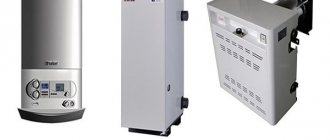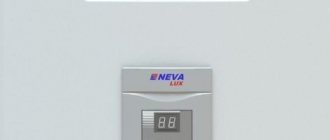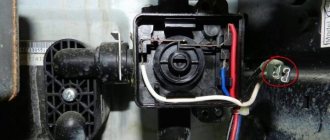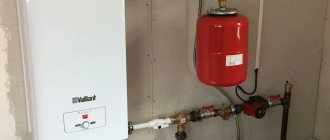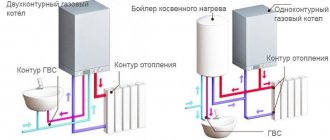Ideal situation: your house is still at the design stage. It is better to select a heating system right now, in order to provide for everything: where to install the boiler, how to install pipes and organize the supply of fresh air.
If the house is already standing, it doesn’t matter. In most cases everything will be fine and no adjustments will be required. In the struggle for buyers, heating boiler manufacturers have been improving their products for many years. There is likely a solution on the market that will suit you.
To better understand the topic of heating, let’s try to find answers to the main questions.
Wall-mounted or floor-standing gas boiler
According to the installation method, gas boilers are of two types:
- wall;
- floor
The first type provides for mounting to the wall, so it has a small weight - no more than 80 kg. The power of such units can reach 35 kW (more powerful ones are rare), and the capacity of the built-in boiler does not exceed 40 liters. Wall-mounted models are an excellent solution for small private houses with an area of about 100 m2 - 120 m2.
Although these devices have low power and low heating capabilities, they have their advantages:
- for a wall-mounted boiler you do not need to allocate a special room - just place the device in the bathroom or kitchen;
- Most wall-mounted units are equipped with a closed combustion chamber, and the chimney can be removed through a hole in the wall.
Floor-standing boilers are larger and heavier: the mass of such units can exceed 100 kg. Installation of such equipment implies the creation of a boiler room in compliance with the requirements of specialized SNiPs.
The rules regulate important parameters of room equipment: ceiling height, dimensions of the podium for boiler equipment, air exchange rates. The combustion chamber of floor-standing units is predominantly open. This means that a constant flow of air is required for normal operation. However, floor-standing boilers have more power than wall-mounted ones.
Wall-mounted units have a weak point - the heat exchanger. This part is often made of steel to reduce the cost of the boiler and reduce its weight. Condensate, which has acidic properties, forms on the walls of the heat exchanger, which leads to the destruction of the steel part. The cost of replacing a heat exchanger reaches 50% of the price of the boiler itself. Copper is more resistant to corrosion, so copper heat exchangers have a long service life, but the price of copper elements is higher.
When producing floor-standing devices, there is no need to reduce weight, so heat exchangers for such units are often made of cast iron. The main advantages of this material are heat capacity and durability. The service life of cast iron reaches 50 years. However, such a heat exchanger has a drawback - fragility. In addition, sudden temperature changes in the supply and return pipes negatively affect cast iron.
When choosing between a floor-standing and wall-mounted gas boiler, it is necessary to take into account that wall-mounted units are often cheaper, since they are equipped with an expansion tank and a circulation pump. For floor-standing equipment, these parts must be purchased separately, which results in additional costs.
Wall-mounted gas boiler equipped with a tank and circulation pump.
In some cases, a heating system with a single-circuit boiler is filled not with water, but with a special antifreeze. This liquid does not lead to corrosion of metal parts and allows you to increase the service life of the boiler and pipeline. Unlike water, antifreeze does not freeze at subzero temperatures, so in winter a heating system with antifreeze does not fail (and water can freeze and damage pipes).
Antifreeze can only be used in floor-standing boilers. It is not suitable for wall-mounted models, as it can lead to deformation, leaks and local environmental disaster. This fact must be taken into account when choosing a gas boiler for periodic use in winter, for example, in country houses.
How much power do I need?
The power of a heating boiler is determined not only based on the area of the house. The calculation takes into account: ceiling height, thickness and material of walls, quality of insulation, location of the boiler and other parameters. Offhand, you can focus on this ratio: 1 kW for every 10 m². A specialist will help you make an accurate calculation.
To calculate the approximate boiler power, use a simple formula:
1 kW = 10 m².
For independent calculations, you can use the professional engineering program VALTEC.PRG. It takes into account a lot of parameters and allows you to accurately calculate heat loss for any home. The program is free and can be downloaded from the official website. There are also training videos with calculations using specific examples: one, two, three and four.
Single-circuit or double-circuit gas boiler
A single-circuit gas boiler is a device with one line that has one heat exchanger. Such boilers were originally intended for heating a country house and for installing heated floors.
The double-circuit gas unit is equipped with two heat exchangers. The device is connected to two independent lines, one of which is intended for heating, and the second for supplying hot water.
Heating water for hot water supply can be done in one of three ways:
- Heating using a flow-through boiler heater.
- Heating using a tank built into the boiler.
- Heating in a separate boiler.
It would seem that you can purchase a double-circuit boiler for a house in which a large family lives, but for a house where you only come for the weekend, a single-circuit boiler is sufficient. But in reality, such a solution will not always be optimal.
The main disadvantage of dual-circuit units with a flow-through water heating system is that heating and hot water supply cannot operate simultaneously, but are turned on one at a time. That is, while you are taking a shower, the radiators in the house are cooling down. At the same time, boilers with a power of up to 25 kW are not able to maintain a sufficiently high temperature for two water intake points at once.
That is, when one person takes a shower in the bathroom and the other decides to wash dishes in the kitchen, the shower will automatically become contrasting. Even buying powerful models does not save the situation - because even with a connection diameter of ½ inch, the water flow will not improve much.
Double-circuit gas boiler.
If the tap is more than 5 meters away from the boiler, then after you turn on the water, you will need to wait 10-15 seconds for the cold water to change to hot. To solve this problem, you can get a double-circuit gas unit with a built-in boiler, which constantly has hot water. The capacity of such a tank reaches 40 liters, sometimes more: this is enough for an express shower, but not for taking a bath.
Double-circuit gas boiler with built-in boiler.
In cases where hot water is required constantly and for comfortable use of hot water supply, it is recommended to purchase a single-circuit unit and additional equipment - an indirect heating boiler. A free-standing boiler is used in cases where a large volume of stored hot water is needed - about 100–200 liters.
This device is a capacious metal container with thermal insulation. Inside the boiler there is a coil connected to the heating system of the house. Heated water or antifreeze moves along the coil, as a result of which the water in the tank heats up. If a small family lives in a house, then a 100 liter boiler is sufficient. If the boiler is turned off, the water in the boiler does not cool down quickly.
Single-circuit gas boiler with indirect heating boiler. Photo: PROTON+ Company.
The disadvantages of such a system of a single-circuit boiler and an indirect heating boiler include:
- higher cost of such a combination compared to a dual-circuit unit;
- the need for a separate room as a boiler room.
At the same time, this combination of equipment allows for recirculation of hot water supply: opening any tap, you will immediately receive hot water. Additionally, you can connect a heated floor or heated towel rail to the system, which will function when the heating is turned off. Recycling is convenient, but not always profitable from an economic point of view.
If hard water is supplied through the pipeline, then buying a double-circuit boiler is not the best solution. This may result in the need to replace the secondary heat exchanger. The cost of such repairs can reach 50% of the price of the boiler itself. In fact, dual-circuit units are designed for small houses and apartments, as they take up less space and save space.
Advice: sometimes the best option may be a double-circuit gas boiler in combination with an electric boiler. Thanks to such equipment, there will always be hot water in the house, even if one of the devices breaks down.
Liquid fuel devices for home heating
Liquid fuel heating devices usually use diesel fuel, oil or gasoline. Such a system works completely autonomously, and its characteristics are quite good: the room is heated quickly, and the heat lasts for quite a long time. But liquid fuel heaters have their weaknesses. Firstly, the installation of such a boiler requires a separate room, which will be maximally protected from a possible fire, therefore it is advisable to place liquid fuel heating boilers in brick extensions equipped with an exhaust hood. Secondly, the need for constant refueling suggests that it needs to be stored somewhere - and storing diesel fuel or gasoline is quite dangerous, since these substances can cause serious harm if stored incorrectly.
When choosing a boiler that runs on liquid fuel, you need to think about it in advance and consider alternative heating options, since many of them have a better level of fire safety than liquid fuel devices.
Convection or condensation gas boiler
Depending on the heating method, gas boilers are divided into two types:
- convection (or traditional);
- condensation
It is this feature that should be taken into account first of all when purchasing a boiler. However, before making the final choice of the desired type, you need to learn more about the features of this boiler equipment.
The operating principle of a convection boiler: fuel burns and heats water, and the resulting gases are removed through the chimney. The temperature of the gases exceeds 100°C, so they escape without having time to cool down to the dew point and without leaving condensation on the surface of the pipes. The efficiency of a traditional boiler is about 90%.
In this case, partial losses of thermal energy occur when hot gases escape into the chimney. For example, if the burner power is 20 kW, then only 18 kW is used to heat the coolant.
1. Connecting the chimney. 2. Supercharger. 3. Heat exchanger.
4. Combustion chamber. 5. Burner. 6. DHW heat exchanger.
7. Priority valve. 8. Circulation pump.
To increase efficiency, condensing boilers use exhaust gas heating. That is, the liquid goes through two stages of heating - by exhaust gases, and then heating by gas combustion. As the flue gases cool, the share of energy used for its intended purpose increases.
Modern condensing-type boiler units are more economical if certain conditions are met. Condensation takes place inside the boiler, so not only the energy from gas combustion, but also the heat generated during the condensation process is used most fully. This is called the higher calorific value. Thanks to condensation, it is possible to obtain a significant increase in heat, reaching 11%. In practice, the efficiency of condensing boilers is 106–109%. Here the efficiency exceeds 100% due to the fact that the higher calorific value of combustion is not taken into account when calculating the efficiency of traditional boilers.
1. Chimney. 2. Expansion tank.
3. Heat transfer surfaces. 4. Modulating burner.
5. Burner fan. 6. Pump. 7. Control panel.
It would seem that the massive replacement of boiler equipment with condensing units will lead to a mass effect. However, the situation is not so simple. When the gases cool to 57°C, condensation will begin. The water vapor present in the gases will gradually turn into a liquid state, accumulating chemically active substances. The condensate formed inside the boiler is highly chemically reactive, therefore the heat exchanger must be made of an appropriate material. Some of the aggressive condensate enters the chimney, so it must also be resistant to such effects. The resulting liquid must be removed from the system, for example, into the sewer (if regulatory authorities allow condensate to be drained there).
However, this is not always possible: often boilers are placed in basements that are not equipped with a sewage system. When using a septic tank, it will not be possible to drain condensate into the sewer system, as this will lead to disruption of its operation. Therefore, additional equipment may be needed - equipment that chemically neutralizes condensate, as well as consumables for it.
As a result, the cost of a condensing boiler is significantly higher, a conventional chimney is not suitable for it, and the problem of condensate disposal must be solved. If the increase in thermal power reaches 10–15%, then this will be beneficial. However, such an increase is only possible in the best case scenario.
To cool the flue gases, it is necessary to take thermal energy from them and transfer it to the water entering the boiler. In this case, it is necessary to take into account what type of heating system is used: low-temperature or high-temperature heating system. Low-temperature heating systems include water heated floors.
If a water heated floor is installed in the house, then water with a temperature of about 30°C enters the boiler. Condensation occurs at temperatures around 55°C. Therefore, in such a situation, it is possible to effectively cool the flue gases so that condensation takes place in the boiler.
Water heated floor.
But in cases where radiators are used to heat rooms, the temperature of the coolant at the entrance to the boiler remains high - on average about 50°C. At such indicators it is not possible to sufficiently cool the gases. As a result, only partial condensation occurs in the boiler, and a significant portion of the combustion products is cooled in the chimney.
Thus, condensing-type boiler equipment can only operate effectively in cases where the heating system has a low-temperature circuit. In systems with radiator heating, the efficiency will be slightly higher than that of a traditional boiler, but will not reach the maximum possible value. In practice, when the water temperature drops from 80 to 50°C, the efficiency coefficient averages 95–98%.
When calculating the power of condensing equipment, it is necessary to clarify the required thermal power and take into account the efficiency in the given conditions. The documentation usually indicates at least two efficiency values: for a difference of 80–50°C and for 50–30°C. Therefore, you need to choose a boiler taking into account the type of heating system.
Which gas boiler is better and whether it is worth installing a condensing model must be decided in each individual case. For example, if in a high-temperature heating system you simply replace the boiler with an expensive condensing boiler, then the increase will not be significant. With new construction and installation of heated floors, you can get about 15 additional percent of power.
Solid fuel heat generators
Such boilers use a much more modern heating principle: the heat generated by the system does not go directly into the air or onto nearby surfaces, but into the piping system, which ensures the distribution of heat throughout the building. How it's done? Pipes are connected to the boiler, receiving thermal energy due to fuel combustion. The other ends of these pipes are carried throughout the room or to other rooms, where the heated coolant is dispersed through the air.
Heat generators can operate autonomously, but to ensure greater efficiency, you can use a “snail” - an electric fan that increases the amount of air entering the combustion chamber. This device allows you to significantly increase the amount of energy entering the pipeline over a certain time.
Despite their good performance, solid fuel heat generators cannot be called the best, since they have the following disadvantages:
- Price
. A good generator with excellent performance will be quite expensive, which is not always acceptable for homeowners. - Partial energy dependence
. Despite their autonomy, solid fuel heat generators still use electricity to improve performance.
But the obvious advantages of such devices include their versatility: such heat generators can be used in any buildings, both private and industrial.
The best wall-mounted gas boilers
Bosch Gaz 7000 W MFA
The lineup.
This line of the German brand includes five models running on main and liquefied gas. These are wall-mounted devices with a closed combustion chamber, boiler power 24, 28 and 33 kW. Economical devices are effective for heating and hot water supply. Additional advantages of these units are ease of installation and compactness.
Preparing hot water.
The line includes double-circuit models equipped with two heat exchangers for hot water supply, and single-circuit models that require additional installation of a boiler.
Design features.
- Atmospheric burner made of stainless steel with the ability to operate on liquefied gas.
- Primary monothermal heat exchanger.
- The presence of a three-way mixing valve with an electric drive for connecting the boiler.
- Electronic ignition.
- Two-mode hot water preparation: Comfort for constantly maintaining a high temperature and Eco for heating water when necessary.
- Protection from boiler pump from blocking, freezing, scale.
- Thermal inertia elimination system.
- Boiler protection against Legionella.
Equipment.
The equipment provides the ability to modulate power in DHW and heating modes. There is a Bosch Heatronic 3 control module, the safety system is built into the control board. The units are equipped with a self-diagnosis system with wide functionality.
Additional Information.
Boiler efficiency is 91%. The devices are equipped with a large set of remote controllers, thermostats, weather-dependent programmers and timers. Thanks to compatibility with solar systems, it is possible to change the settings of the heating and water supply system taking into account the intensity of exposure to the sun.
Baxi Eco Four
The lineup.
Italian wall-mounted boilers presented in this model range operate on liquefied or main gas and have a power of 14 and 24 kW. The line includes three models of heating equipment intended for country houses, cottages and offices. These devices are in great demand in the Russian market due to their performance, compact size and many other qualities.
Preparing hot water.
Double-circuit models allow you to heat water in flow-through mode, and when installing a single-circuit boiler, you will need to connect an indirect heating boiler to provide hot water.
Design features.
- Primary heat exchanger made of copper.
- Burner and heat exchanger for DHW made of stainless steel.
- Protection against blocking and freezing.
- The circulation pump is equipped with an air vent operating in automatic mode.
- The lowest permissible gas pressure is 5 mbar.
- Automatic bypass.
- Smooth electronic ignition and electronic flame modulation.
- Heated water flow sensor.
Equipment.
A programmable timer and thermostat can be connected to the device. A liquid crystal screen is used to display information about the operation of the system. The boilers of this model range are equipped with an electronic self-diagnosis system with the ability to display a blocking signal on the control panel.
Additional Information.
You can connect an outdoor temperature sensor to the devices, since they have built-in weather-dependent automation. The temperature in the heating circuit is regulated and maintained automatically.
Vaillant turboTEC plus VU INT
The lineup.
This model line of the Vaillant brand (Germany) includes 6 boiler models. All models can use main or liquefied gas as fuel. The power of wall-mounted units varies from 12 to 36 kW. All models in this line are single-circuit, equipped with a closed combustion chamber.
Preparing hot water.
All boiler models are single-circuit and are intended only for the heating system. To prepare hot water, you need to install an indirect heating boiler. It can be combined with a variety of VIH water heaters.
Design features.
- Copper primary heat exchanger.
- Chrome-nickel steel is used to make the burner.
- The circulation pump is equipped with an automatic stage switch.
- Frost protection system and constant pressure monitoring in the heating system.
- Closed expansion tank.
- Automatic air vent.
- Electronic ignition.
- The equipment has a built-in switching module for the e-bus interface.
Equipment.
The boilers are equipped with automatic bypass and safety valves. There is a priority change-over valve with an electric drive. The devices provide protection against jamming of the pump and three-way valve resulting from downtime. The backlit LCD display allows you to monitor status, and the diagnostic system helps you quickly detect faults.
Additional Information.
The efficiency exceeds 91%. In heating mode, it is possible to set it to partial power. It is permissible to assemble a cascade structure based on boilers of this line.
Protherm Panther KTV
The lineup.
This model range of the brand from Slovakia includes two models of wall-mounted double-circuit gas boilers with a closed combustion chamber. Units with a power of 24 and 29 kW are capable of operating on mains or liquefied gas. A distinctive feature of this line is increased comfort in use and maintenance.
Preparing hot water.
Hot water is prepared in a steel plate heat exchanger or in a separate storage boiler. Water is heated at a speed of 14 liters per minute.
Design features.
- Plate heat exchanger for hot water supply, made of steel.
- The combustion chamber is closed type.
- Efficiency 91–92.8%.
- Automatic flame modulation.
- Independent regulation of thermal loads of the heating system and hot water supply.
- Microprocessor control.
- Built-in circulation pump equipped with an automatic air vent.
- Built-in feed valve for filling the heating system with liquid.
Equipment.
Equipment operation diagnostics are performed automatically. There are two control modes: “Comfort” and “Winter - Summer”. The boiler is protected from overheating and freezing, there is a built-in control for the presence of flame and draft in the chimney, as well as a pump anti-blocking system. Devices of this model range are capable of working with weather-compensated automation. The operating parameters of the heating system, information about malfunctions and maintenance requirements are displayed on the liquid crystal display.
Additional Information.
Boiler equipment can operate fully automatically throughout the year. During operation, the temperature of the water is monitored not only at the inlet of the heating system, but also in the return line. Thanks to this, the most accurate adjustment of the unit’s power is achieved. Using an intelligent control system, it is possible to reduce the number of equipment starts and stops and extend its service life.
The best floor-standing gas boilers
Vaillant atmoVIT VK INT
The lineup.
This line of the brand from Germany includes six floor-standing gas boilers, the power range of the units is from 16 to 56 kW. The devices are equipped with an atmospheric injection burner without a fan. These boilers can be used as heat generators to provide heating and hot water supply. Natural gas is used as fuel, but when reconfiguring the equipment, it is possible to use liquefied gas.
Preparing hot water.
One of the models is capable of producing instantaneous heating of water; the rest require the installation of an indirect heating water heater to prepare hot water.
Design features.
- Sectional heat exchanger made of cast iron.
- Atmospheric injection burner.
- High efficiency rates reaching 92%.
- Low emissions.
- Electronic ignition and built-in flame detection system.
Equipment.
The devices are equipped with built-in temperature and draft sensors. The burner has ceramic rods to dissipate heat, as well as an automatic pressure regulator. It is permissible to connect various analogue type regulators. The equipment is equipped with a safety temperature limiter. An additional convenience is the ability to adjust the height of the boiler legs.
Additional Information.
Thanks to the cast iron heat exchanger, the durability of such boilers is excellent. Therefore, the equipment will serve for a long time and delight its owners.
Viessmann Vitogas 100-F 29-60
The lineup.
This line includes 15 models of boilers with power ranging from 29 to 60 kW. The equipment combines economical fuel consumption with high efficiency (92%). When choosing which gas boilers are the most economical and practical for your home, you should pay attention to the units from this model range. The devices have high operational reliability even with significant fluctuations in pressure in the gas pipeline and voltage in the electrical network.
Preparing hot water.
To provide DHW, it is necessary to combine the device with a capacitive storage tank.
Design features.
- Stainless steel rod burner.
- Durable heat exchanger made of gray cast iron.
- Full automation of the work process.
- Silent ignition and high ignition reliability.
Equipment.
The units are equipped with a gas pressure control relay, necessary in cases of low pressure. Digital software control of the boiler operation is provided.
Additional Information.
The devices have good fuel efficiency and compact dimensions. Boilers in this series are environmentally friendly and meet Blue Angel requirements.
Protherm Bear KLOM17
The lineup.
Slovak floor-standing boilers in this line are represented by four models. The power of the devices is 17–44 kW, and main gas or liquefied gas is consumed as fuel. Gas equipment is intended for heating private homes and small commercial facilities.
Preparing hot water.
Boilers are designed for heating, but heating water for hot water supply is possible in an external boiler.
Design features.
- The efficiency reaches 90–92%.
- The two-pass heat exchanger is made of cast iron with condensation protection and has from 4 to 8 sections.
- Open combustion chamber.
- Stainless steel atmospheric burner.
- Electric ignition.
- Smooth power adjustment.
- Built-in draft and flame control system.
- Overheat protection and cooling circuit.
Equipment.
The boilers are equipped with built-in microprocessors that allow you to effectively control the equipment in the “Winter - Summer” mode. Indication of pressure and temperature indicators and work with weather-dependent devices are provided.
Additional Information
The equipment is stable when operating in any hydraulic modes, and is supplied fully assembled. The boilers are easy to install and maintain. The middle sections of the cast iron heat exchanger can be replaced.
Baxi Slim
The lineup.
The line of floor-standing boilers Baxi (Italy) is represented by 10 models with a capacity of 22–62 kW. The units operate on liquefied and main gas. The devices in this wide range are equipped with a cast iron heat exchanger.
Preparing hot water.
Double-circuit models have a built-in hot water boiler. It is possible to connect an external storage boiler.
Design features.
- Self-diagnosis system.
- Durable heat exchanger made of cast iron.
- Electronic flame modulation.
- Efficiency reaches 90.5%.
- Two temperature control ranges (for operation in radiator heating and underfloor heating modes).
Equipment.
The boilers have built-in protection systems against freezing, overheating and blocking, and flame control. The equipment is equipped with high-speed circulation and post-circulation pumps, built-in weather-dependent automation, draft sensor, pressure gauge and safety valves.
Additional Information.
The boilers are compact in size and have a modern design. Provision is made for regulation and automatic maintenance of the set temperature in the heating circuit and in the boiler. You can additionally connect a programmable timer.
Bosch Gaz 2500 F
The lineup.
The model range is represented by five boilers, the power of the units is 22, 26, 33, 42, 50 kW. Main gas is used as fuel. Boiler equipment is designed to provide heat and hot water to a house with an area of up to 500 m2.
Preparing hot water.
The units are capable of working with free-standing indirect heating boilers.
Design features.
- The heat exchanger is made of 3 mm thick steel.
- It is possible to adjust the power depending on the load in the range from 60 to 100%.
- Highly efficient boilers with an efficiency of 92%.
- Large diameter connection of the boiler unit to the heating system.
Equipment.
Boilers in this line are equipped with a modern control system, disinfection function and frost protection.
Additional Information.
To increase operating comfort, it is possible to connect regulators. The devices are easy to install and operate, and are fully adapted to Russian conditions of use. During operation, DHW priority is ensured over heating. In the “Summer” mode, the device functions only to provide hot water supply.
Advantages and disadvantages
The advantages of floor-standing boilers include:
- no restrictions on the power of the unit;
- strength, reliability of all components and parts;
- ease of installation;
- stability of operation, the ability to maintain a given mode regardless of external conditions;
- no unnecessary additions;
- powerful models can be connected in a cascade of up to 4 units, forming high-performance thermal units.
The disadvantages of floor structures are:
- large weight, size;
- the need for a separate room;
- for atmospheric models it is necessary to connect to a common house chimney
IMPORTANT! In addition to a separate room, for floor-standing boilers it is necessary to ensure the possibility of connecting to a vertical chimney or leading a horizontal pipe through the wall.
The best condensing gas boilers
De Dietrich Innovens PRO MCA
The lineup.
Condensing boilers of the French brand have a power from 43 to 114 kW and a closed combustion chamber. There are eight models in total in this line. The devices are wall-mounted, have a stylish modern design and are small in size. They are perfect for the bathroom or kitchen. Thanks to improved energy saving indicators, increased productivity and safety, these units occupy high positions in the rating of gas boilers in terms of reliability and quality.
Preparing hot water.
Boilers of this model range provide comfortable heating and hot water in the required volume.
Design features.
- The efficiency reaches 102.5%.
- Monoblock heat exchanger made of aluminum and silicon alloy.
- Steel burner with noise suppressor.
- The shell that insulates the body is made of composite materials.
- Automatic electric ignition.
- Built-in sensors for flame control.
- Reduced noise level thanks to the use of a centrifugal fan.
- Siphon for condensate.
- Automatic air vent.
- Internal LED lighting for easy maintenance.
- Flue gas temperature sensor.
- Control and self-diagnostic systems.
Equipment.
There are two control panels to choose from: the basic IniControl and the weather-compensating Diematic iSystem. Installing an additional outdoor temperature sensor allows you to modulate the burner power taking into account external temperature indicators. All system operating parameters and boiler status are displayed on the liquid crystal display.
Additional Information.
Devices of this model range have not only high efficiency, but also low noise levels, as well as low levels of harmful emissions.
Viessmann Vitodens 100-W
The lineup.
The line includes five wall-mounted condensing units operating on mains and liquefied gas. The boiler power is 19–35 kW. They are suitable for creating heating systems in private homes and commercial buildings. Models in this line represent the optimal combination of performance, reliability and competitive prices.
Preparing hot water.
Thanks to the plate heat exchanger of double-circuit models and the temperature controller, comfortable preparation of hot water is possible. For single-circuit units, installation of an indirect heating boiler is required.
Design features.
- The efficiency is 108%.
- Low content of harmful substances in exhaust gases.
- By adjusting the fan speed, good efficiency is achieved.
- Heat exchanger made of stainless steel with increased corrosion resistance.
- Cylindrical steel burner.
- Economical modulation combustion principle.
- Electronic control system.
Equipment.
The boiler is equipped with protection systems against blocking, overheating and freezing. The operation of the device is regulated by wired and wireless regulators - digital and analogue room thermostats. The unit is equipped with an integrated expansion tank, a fan with adjustable rotation speed, and a digital control device.
Additional Information.
When servicing the equipment, no additional space is required, since all elements are accessible from the front.
Vailliant ecoTEC plus VU OE
The lineup.
This series includes only two models of single-circuit boilers. These Vaillant condensing boilers (Germany) have a power of 45 and 65 kW. The advantages of the units include efficiency and environmental friendliness. The boilers are used in low-temperature heating systems and are well suited for installing a boiler room on the roof.
Preparing hot water.
To prepare hot water, the installation of a cylinder water heater is required.
Design features.
- The average efficiency value during the heating season is 109%.
- Wide modulating burner power range (28–100%).
- Automatic air vent.
- Two-stage pump with automatic switch.
- Adjustable fan speed.
- Expansion tank.
- Built-in siphon for condensate removal.
- Safety valve.
Equipment.
To effectively use the thermal energy of condensation, the Aqua-Kondens system is used. The boilers have electronic ignition and a combustion control system. An integrated switching module is provided for the e-bus interface.
Additional Information.
To support combustion, you can use air from the room or coming from outside. It is possible to adjust and set partial power for hot water supply and heating.
Types of water heating devices
All modern heating boilers used in private houses and apartments are divided into groups according to the following criteria:
- consumed energy carrier – natural gas, electricity, solid fuel, etc.;
- by installation method - floor and wall;
- in terms of functionality - single-circuit and double-circuit, the latter additionally heats water for hot water supply;
- need for electrical connection - dependent and non-volatile.
We propose to consider boiler installations, dividing them according to the main criterion - the energy carriers used. Existing types of devices:
- gas;
- solid fuel;
- electrical;
- diesel;
- combined, otherwise multi-fuel.
Now we will analyze each group separately, covering in detail all the disadvantages and advantages of boilers.




